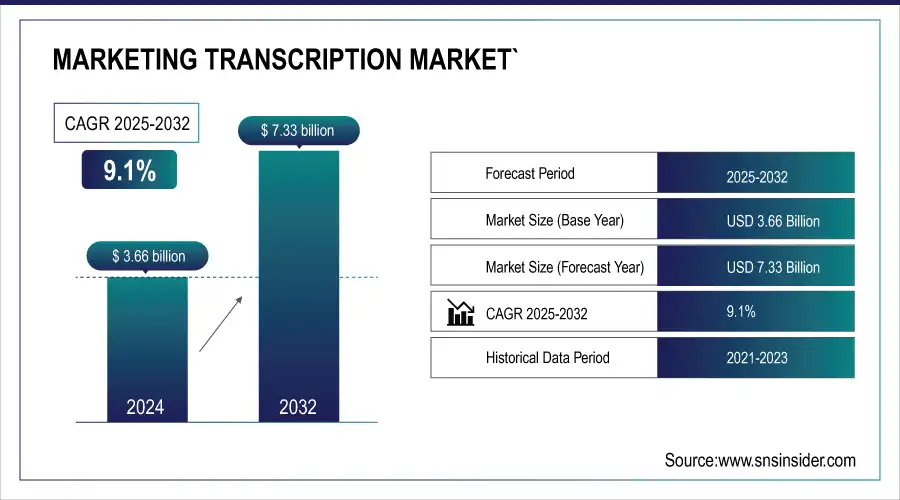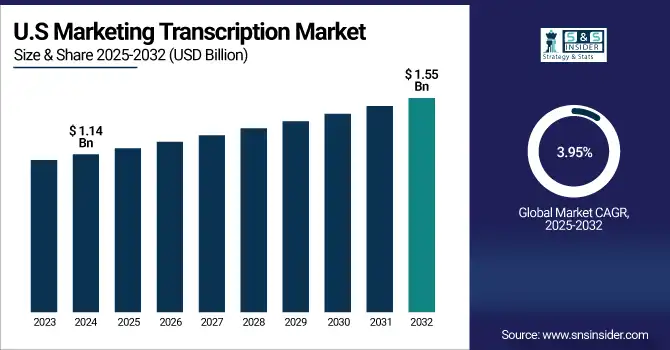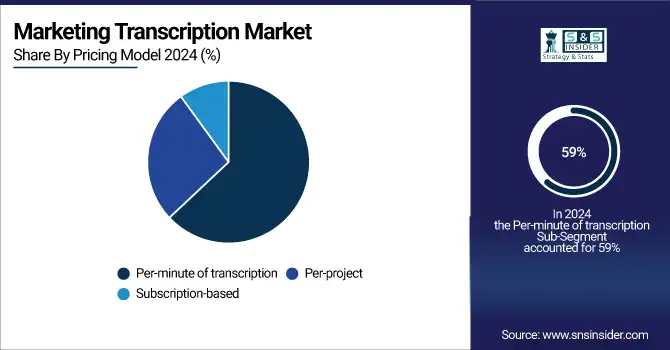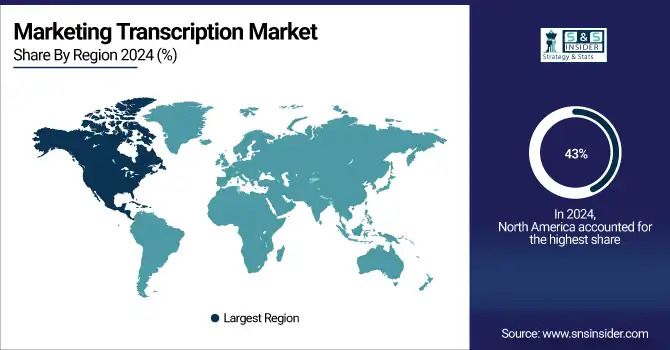Marketing Transcription Market Report Scope & Overview:
The Marketing Transcription Market Size was valued at USD 3.66 billion in 2024 and is expected to reach USD 7.33 billion by 2032 and grow at a CAGR of 9.1% over the forecast period 2025-2032.

To Get more information On Marketing Transcription Market - Request Free Sample Report
The is experiencing strong growth, driven by advances in speech recognition technology and the increasing need for accurate, real-time transcription services in marketing communications. This technology allows marketers to quickly transform audio or video formats of content, such as interviews, webinars, podcasts, and focus group sessions, into text material for comprehensive analysis of the content and better audience interaction. With the ability to fully customize verbatim transcription, marketing teams can have flexibility in terms of how they tailor outputs to the needs of the campaign.
With 95% of businesses having made webinars an essential part of their marketing strategy and 76% using them specifically for lead and sales generation, the need for dependable transcription services is higher than ever. These marketing transcription market trends emphasize the need for transcription as a tool that enables marketers to improve content accessibility, optimize messaging, and leverage competitive intelligence, making it an inherent requirement for those looking to leverage their campaigns through effective content management and analysis. Specifically, around one quarter of organizations host more than 50 webinars every year, and 41.7% have increased the frequency of webinars they host. These trends indicate an increasing need for accurate and fast transcription services for better content reach and analysis.
The U.S. Marketing Transcription Market size was USD 1.14 billion in 2024 and is expected to reach USD 1.55 billion by 2032, growing at a CAGR of 3.95% over the forecast period. The U.S. marketing transcription market analysis is driven by the rising adoption of cutting-edge AI-based speech recognition technologies that provide an instant conversion of audio to text format for various marketing content, such as webinars, podcasts, and focus groups. The rising need for effective content consumption analysis and enhanced audience engagement adds market value. North America has the largest number of digital marketing agencies in the U.S, along with higher internet penetration and use of virtual events and webinars. It has been quick to embrace new technologies and solutions, but the country has a strong technology infrastructure.

Marketing Transcription Market Dynamics
Key Drivers:
-
Accelerated Adoption of AI-Powered Transcription Tools Enhances Efficiency in Marketing Content Processing
The marketing transcription market growth is mainly attributed to the increasing implementation of transcription tools that work on AI. With these smart solutions, businesses can accurately transform audio & video content, including webinars, podcasts, interviews, etc., into text format quickly and economically. Artificial intelligence (AI) and machine learning (ML) technologies have disrupted transcription services by processing content in real-time and minimizing human effort. Besides being so incredibly fast at churning out content, it does this with extreme accuracy, making it a must-have for marketing teams that want to repurpose content to countless different platforms effectively. According to a study, the rapidly increasing adoption of AI-powered transcription tools is creating tremendous efficiency in processing marketing content. HubSpot also reveals that repurposed content has 60% of marketers claiming that it generated more leads than the original version. The Content Marketing Institute found that two-thirds of marketers have seen improved results from reusing high-performing blog posts in different formats, as well.
Restraints:
-
Concerns Over Data Privacy and Confidentiality Pose Challenges to Market Expansion
As transcription services often handle sensitive information, ranging from proprietary business strategies to personal customer data, ensuring the security of this information is paramount. Data breaches are a goldmine for criminals but a lose-lose for businesses, who gain a well-deserved black eye and are then hit with fines. Adding to the complexity are differing international data protection laws, including the General Data Protection Regulation (GDPR) in Europe and the California-based California Consumer Privacy Act (CCPA) in the United States, which would require rigorous measures regarding how such data is stored and managed. Meeting these regulations means the transcription service provider will be implementing strong security provisions, including end-to-end encryption, a secure data store, and a strict access control mechanism. Failure to comply with these standards can lead to hefty penalties and lost customer loyalty. As a result, worries of data security and privacy may prevent certain organizations from completely relying on transcription services, which in turn acts as a challenge to the growth of the market. Clear methods and best-in-class security protocols are needed to allay such concerns if the market is to be maintained and expanded.
Opportunities:
-
Emergence of Multilingual Transcription Services Opens New Avenues in Global Marketing Strategies
The globalization of business operations has underscored the importance of multilingual transcription services in the Market. In the age of globalization, as companies try to reach a wide variety of audiences with their different languages and cultures, the need for accurate transcriptions that are sensitive to cultural context has arisen. With multilingual transcription businesses can localize their marketing contents such as advertising, webinars, social media campaigns, etc., making them relatable and effective in different regions.
As per a report, 84% of marketers worldwide agree that localization drives revenue growth. In addition, Unbabel conducted a global survey revealing that 89% of marketers from medium-to-large companies will localize content in more languages in the next twelve months. These stats speak to the even more important need for marketing content in multiple languages, catered to various cultural demographics. Not only does this accommodate the rise in the demand for advocacy and translated messages, but it also makes these providers valuable allies in any global marketing campaign.
Challenges:
-
The complexity of Industry-Specific Terminologies Challenges Accuracy in Automated Marketing Transcriptions
A significant challenge confronting the market is the transcription of domain-specific words. Various sectors, such as legal, medical, and technical fields, employ some jargon that generic transcription algorithms find hard to decipher. Legal transcriptions require the same replication of language to ensure the integrity of the document. Automated transcription tools try to be efficient but fail miserably on those nuances, resulting in errors that require manual fixing.
This not only increases the time and cost involved but also undermines the reliability of automated solutions. In order to combat this problem, a few service providers have started developing domain-specific algorithms, specifically developed for a particular industry, using a proprietary data set on that industry. But building and sustaining these purpose-built solutions need significant resources and continual updates to keep up with the evolving terminology. The challenge of industry language remains one of the toughest challenges for accurate automated marketing transcriptions.
Marketing Transcription Market Segments
By Solution Type
In 2024, the Speech-to-Text Transcription segment holds the largest revenue share of 52% in the market. The increasing demand to automatically and accurately convert verbal content in webinars, interviews, and podcasts drives this dominance. Transcription tools have also become increasingly advanced, with many forward-looking companies embedding real-time processing, keyword tagging, and summary generation into their product extensions. These advancements allow marketing teams to quickly generate content, optimize SEO, and reuse a voiceover in many digital outlets easily.
The Audio Editing and Enhancement segment is projected to grow at the highest CAGR of 14.4% during the forecast period, due to increasing expectations for professional-grade audio quality in marketing communications. Companies are now benefiting from AI audio tools that include background noise reduction, volume balancing, and clarity improvement. Such innovations play an important role in the improvement of sound quality for promotional videos, podcasts, and webinars. Improved sound enhances better message delivery, higher audience interactions, and greater accessibility of content over unlimited digital marketing and multilingual channels.
By Industry Vertical
In 2024, the healthcare industry dominates the marketing transcription market with a 37% revenue share, driven by the increasing use of transcription services that allow the transcription of segments of medical webinars, patient interviews, and training into an accurate transcription text. AI Transcription tools for healthcare innovation features assist in making documentation more efficient, minimizing manual work, and ensuring compliance. These innovations allow Northern Light healthcare marketers to develop highly targeted and actionable content for patient education and outreach, improving engagement and omnichannel communications.
The education vertical is growing at the fastest CAGR of 13.9%, fueled by rising demand for transcription of lectures, seminars, and online courses. Educational institutions are implementing AI-powered transcription solutions to enhance accessibility for students, enable content repurposing, and promote inclusivity in the learning environment. This growth assists marketing efforts with the ease of distributing educational resources across platforms, increasing audience reach and involvement, leading to increased content efficiency in the education sector.
By Pricing Model
In 2024, the per-minute transcription pricing model dominates the Marketing Transcription Market with a 59% revenue share, favored for its flexibility and cost-effectiveness. Leading companies are delivering both transparency and accuracy improvements powered by artificial intelligence technologies, allowing marketers to pay only for the portion of content they need. This model is ideal for businesses that need transcription only sometimes webinars and podcasts, enabling budget management while ensuring accurate transcription that is vital at times for content repurposing and engaging with your audience.
The subscription-based pricing model is growing at the highest CAGR of 13.2%, driven by marketers’ preference for predictable costs and unlimited transcription access. Now, companies rolled out subscription plans with several levels offering unlimited minutes, high-end editing tools, and collab features for marketing teams. Such a model enables writers to create frequent content by offering continuous transcription services, allowing seamless content flow, quicker turnaround time, and the previously mentioned marketing campaign to be executed across numerous platforms, consequently encouraging the growth of the Marketing Transcription Market.

Marketing Transcription Market Regional Outlook
The North America region dominated the Marketing Transcription Market share in 2024 with an estimated market share of 43%. This dominance is driven by advanced AI adoption, strong digital marketing infrastructure, and the high demand of an increasingly digital economy for accurate transcription services across numerous industries. Market growth can be attributed to the rapidly growing AI-powered transcription tools, significant investments in marketing technologies, and a greater emphasis on content personalization.

Get Customized Report as per Your Business Requirement - Enquiry Now
The Asia Pacific region is the fastest-growing market in 2024, with an estimated CAGR of 13.6%, due to increased digitalization and content creation in the marketing transcription industry. India holds the largest share in the Asia Pacific market owing to the growing digital economy, increasing internet penetration, and a rising demand for inexpensive, AI-based transcription services across marketing, education, and media sectors in this region.
In 2024, Europe holds a significant position in the Marketing Transcription Market, driven by the increasing adoption of AI transcription tools and multilingual marketing strategies. Increasing needs for multilingual content, coupled with advanced AI transcription solutions, are expected to drive the market growth in Europe. Due to the presence of developed digital infrastructure and content localization across multiple languages, the region is led by the United Kingdom. In the UK, organizations are pouring vast sums into transcription technologies to strengthen marketing communications and improve accessibility. Europe, as a marketing transcription outlook, serves as a catalyst to propel market growth through innovation and inclusivity.
In 2024, the Marketing Transcription Market in the Middle East & Africa (MEA) region is growing steadily, bolstered by a rising digital marketing adoption and surging investments in AI technologies. This expansion is driven by the increasing need for localized and easy-access marketing content in different languages. Similarly, Latin America is also witnessing fast market growth driven by an increase in demand for digital content creation and growing adoption of cloud-based transcription solutions. Both areas are utilizing transcription services to expand their audience reach and marketing success.
Key Players
The marketing transcription market companies are Rev.com, Otter.ai, Sonix.ai, Trint, Descript, Temi, Verbit, Speechmatics, Scribie, Happy Scribe, and others.
Recent Trends
• In March 2025, Otter. Meetings and Calls: ai revealed a set of AI agents to improve productivity in meetings and calls. The primary highlight of the platform is the Otter Meeting Agent, a voice-driven assistant that leverages company information to answer questions and take care of to-dos.
• In October 2024, an open-source automatic speech recognition (ASR) and speaker diarization model was released on com. This release will improve both transcription accuracy and efficiency and is especially helpful for marketers who need to transcribe and analyze audio content as interviews, webinars, and podcasts.
| Report Attributes | Details |
|---|---|
| Market Size in 2024 | USD 3.66 Billion |
| Market Size by 2032 | USD 7.33 Billion |
| CAGR | CAGR of 9.1% From 2025 to 2032 |
| Base Year | 2024 |
| Forecast Period | 2025-2032 |
| Historical Data | 2021-2023 |
| Report Scope & Coverage | Market Size, Segments Analysis, Competitive Landscape, Regional Analysis, DROC & SWOT Analysis, Forecast Outlook |
| Key Segments | •By Solution Type (Speech-to-Text Transcription, Audio Editing and Enhancement, Translation and Localization, Data Analytics and Visualization) •By Industry Vertical (Healthcare, Education, Media and Entertainment, Legal, Financial Services, Retail) •By Pricing Model (Per-minute of Transcription, Subscription-based, Per-project) |
| Regional Analysis/Coverage | North America (US, Canada, Mexico), Europe (Germany, France, UK, Italy, Spain, Poland, Turkey, Rest of Europe), Asia Pacific (China, India, Japan, South Korea, Singapore, Australia, Rest of Asia Pacific), Middle East & Africa (UAE, Saudi Arabia, Qatar, South Africa, Rest of Middle East & Africa), Latin America (Brazil, Argentina, Rest of Latin America) |
| Company Profiles | Rev.com, Otter.ai, Sonix.ai, Trint, Descript, Temi, Verbit, Speechmatics, Scribie, Happy Scribe, and Others. |

